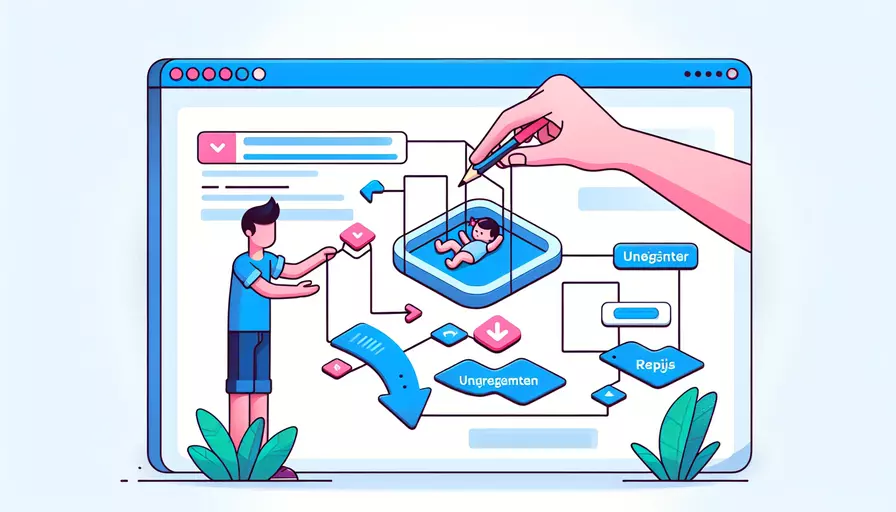
在Vue.js中,注销子组件的方法有多种,主要有1、通过条件渲染来移除子组件,2、使用动态组件来控制子组件的显示与否,3、使用v-if或v-show指令。通过这些方法,你可以灵活地控制子组件的存在与销毁,从而优化应用的性能和资源使用。接下来,我们将详细介绍这几种方法的具体实现和使用场景。
一、通过条件渲染来移除子组件
使用条件渲染(v-if)是最直接也是最常用的方式之一。通过设置一个布尔值来控制组件的显示与隐藏,当布尔值为false时,子组件将被销毁。
<template>
<div>
<button @click="toggleChild">Toggle Child Component</button>
<child-component v-if="isChildVisible"></child-component>
</div>
</template>
<script>
import ChildComponent from './ChildComponent.vue';
export default {
data() {
return {
isChildVisible: true
};
},
components: {
ChildComponent
},
methods: {
toggleChild() {
this.isChildVisible = !this.isChildVisible;
}
}
};
</script>
在上述例子中,通过点击按钮来切换isChildVisible的值,从而控制ChildComponent的显示与否。当isChildVisible为false时,ChildComponent会被销毁。
二、使用动态组件来控制子组件的显示与否
动态组件允许你根据条件动态地渲染不同的组件,这在需要根据不同条件加载不同子组件时非常有用。
<template>
<div>
<button @click="toggleComponent">Toggle Component</button>
<component :is="currentComponent"></component>
</div>
</template>
<script>
import ComponentA from './ComponentA.vue';
import ComponentB from './ComponentB.vue';
export default {
data() {
return {
currentComponent: 'ComponentA'
};
},
components: {
ComponentA,
ComponentB
},
methods: {
toggleComponent() {
this.currentComponent = this.currentComponent === 'ComponentA' ? 'ComponentB' : 'ComponentA';
}
}
};
</script>
在这个例子中,通过改变currentComponent的值,可以在ComponentA和ComponentB之间切换。当切换到另外一个组件时,之前的组件会被销毁。
三、使用v-if或v-show指令
v-if和v-show都是用于条件渲染的指令,但它们的行为有所不同。v-if会在条件为false时移除元素,而v-show只是隐藏元素但不会移除。
<template>
<div>
<button @click="toggleChild">Toggle Child Component</button>
<child-component v-if="isChildVisible"></child-component>
<!-- 或者 -->
<child-component v-show="isChildVisible"></child-component>
</div>
</template>
<script>
import ChildComponent from './ChildComponent.vue';
export default {
data() {
return {
isChildVisible: true
};
},
components: {
ChildComponent
},
methods: {
toggleChild() {
this.isChildVisible = !this.isChildVisible;
}
}
};
</script>
v-if在条件为false时会完全移除DOM元素,适合用于需要频繁销毁和创建组件的场景。v-show则只会切换元素的display属性,适合用于频繁显示和隐藏但不希望销毁组件的场景。
四、使用keep-alive缓存组件状态
如果你希望在组件销毁后保留其状态,可以使用<keep-alive>组件。这在需要频繁切换但不希望每次重新渲染的场景中非常有用。
<template>
<div>
<button @click="toggleComponent">Toggle Component</button>
<keep-alive>
<component :is="currentComponent"></component>
</keep-alive>
</div>
</template>
<script>
import ComponentA from './ComponentA.vue';
import ComponentB from './ComponentB.vue';
export default {
data() {
return {
currentComponent: 'ComponentA'
};
},
components: {
ComponentA,
ComponentB
},
methods: {
toggleComponent() {
this.currentComponent = this.currentComponent === 'ComponentA' ? 'ComponentB' : 'ComponentA';
}
}
};
</script>
使用<keep-alive>包裹动态组件,可以在组件切换时保留其状态,从而避免每次切换时重新渲染。
五、手动销毁组件实例
在某些情况下,你可能需要手动销毁组件实例。Vue.js提供了$destroy方法来实现这一点。注意,这种方式较为底层,通常不建议频繁使用。
<template>
<div>
<button @click="destroyChild">Destroy Child Component</button>
<child-component ref="child"></child-component>
</div>
</template>
<script>
import ChildComponent from './ChildComponent.vue';
export default {
components: {
ChildComponent
},
methods: {
destroyChild() {
if (this.$refs.child) {
this.$refs.child.$destroy();
}
}
}
};
</script>
在这个例子中,通过$refs获取子组件实例,并调用其$destroy方法来销毁组件。这种方式适用于需要完全手动控制组件生命周期的场景。
总结
通过上述几种方法,你可以灵活地控制Vue.js子组件的销毁和缓存。1、条件渲染(v-if)和2、动态组件(
为了更好地应用这些方法,你可以根据具体需求选择合适的技术手段,并结合Vue.js的其他特性优化应用性能。如果你对组件的生命周期有更多需求,可以进一步研究Vue.js的生命周期钩子,例如beforeDestroy和destroyed,以便在组件销毁前后执行特定操作。
相关问答FAQs:
1. 什么是Vue子组件注销?
在Vue中,组件是可以嵌套在其他组件中的,这样的组件关系就形成了父子组件关系。当我们不再需要使用子组件时,为了释放资源和提高性能,我们可以对子组件进行注销。子组件注销的过程实际上就是将其从父组件中移除,并销毁其相关的事件监听和数据。
2. 如何在Vue中注销子组件?
在Vue中,注销子组件有多种方法,下面我将介绍两种常用的方法:
方法一:使用v-if指令
使用v-if指令可以根据条件来判断是否渲染子组件,我们可以通过控制v-if的值来实现注销子组件的效果。当我们将v-if的值设为false时,子组件将会被从DOM中移除,相关的事件监听和数据也会被销毁。
<template>
<div>
<button @click="toggleChildComponent">注销子组件</button>
<child-component v-if="isChildComponentVisible"></child-component>
</div>
</template>
<script>
export default {
data() {
return {
isChildComponentVisible: true
}
},
methods: {
toggleChildComponent() {
this.isChildComponentVisible = !this.isChildComponentVisible;
}
}
}
</script>
方法二:使用v-show指令
v-show指令和v-if指令类似,都是根据条件来判断是否渲染子组件。不同的是,v-show只是通过CSS来控制子组件的显示和隐藏,不会将子组件从DOM中移除,所以相关的事件监听和数据依然存在。
<template>
<div>
<button @click="toggleChildComponent">注销子组件</button>
<child-component v-show="isChildComponentVisible"></child-component>
</div>
</template>
<script>
export default {
data() {
return {
isChildComponentVisible: true
}
},
methods: {
toggleChildComponent() {
this.isChildComponentVisible = !this.isChildComponentVisible;
}
}
}
</script>
3. 子组件注销后会发生什么?
当我们注销一个子组件后,它会被从DOM中移除,并销毁相关的事件监听和数据。这样可以释放内存和资源,提高性能。同时,子组件的生命周期钩子函数也会被触发,可以进行一些清理工作。
需要注意的是,如果子组件注销后再重新渲染,它的状态和数据将会重新初始化,之前的状态和数据会丢失。因此,在注销子组件前,我们需要确保不会再次需要使用它。如果需要保留子组件的状态和数据,可以考虑使用动态组件来进行切换,而不是直接注销子组件。
文章标题:vue如何注销子组件,发布者:飞飞,转载请注明出处:https://worktile.com/kb/p/3622232

 微信扫一扫
微信扫一扫  支付宝扫一扫
支付宝扫一扫 